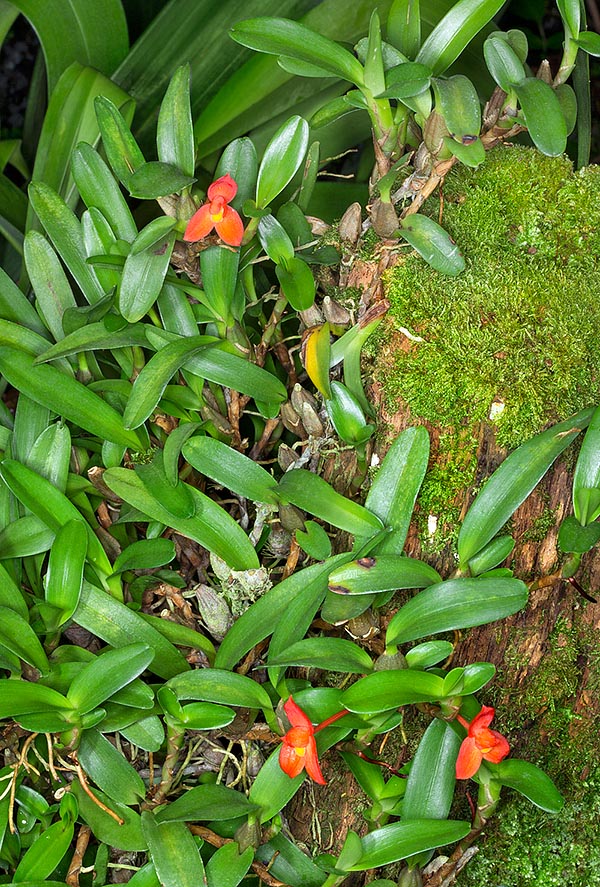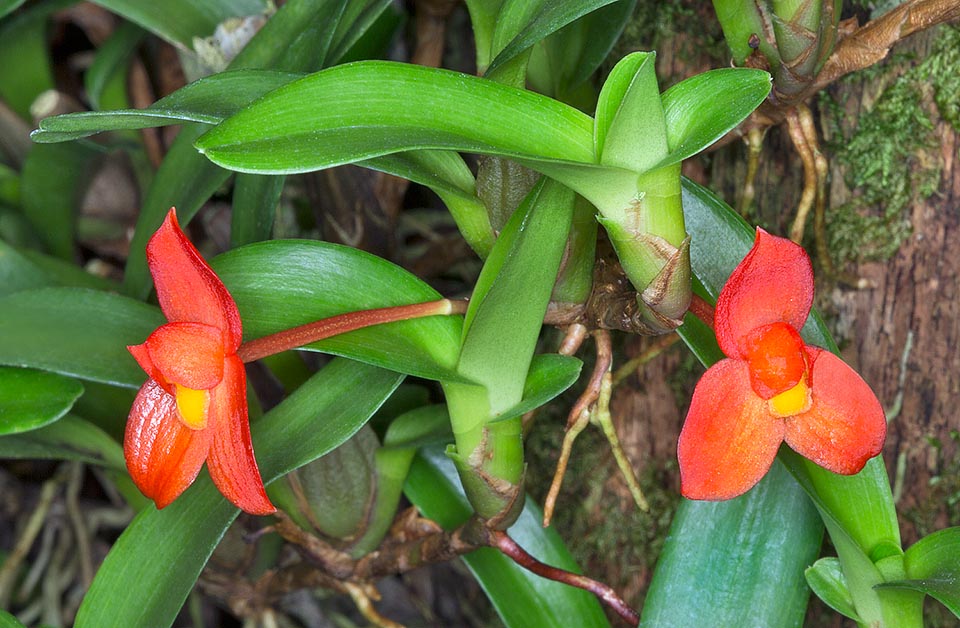Family : Orchidaceae

Text © Pietro Puccio

English translation by Mario Beltramini

Native to Colombia and Venezuela, Maxillaria sophronitis does not exceed the height of 6 cm © G. Mazza
The name of the genus comes from the Latin adjective “maxillaris, e” = maxillary, that concerns the jawbone, with reference to the shape of the nectarium; the name of the species is that of the genus Sophronitis Lindl. (1828) due to resemblance of the colours of the flowers.
The Maxillaria sophronitis (Rchb.f.) Garay (1958) is an epiphytic species, that usually does not exceed the 6 cm of height, with creeping rhizome rooting at the nodes, ramified, wholly hidden by oblong scales with brown acute apex, and pseudobulbs, spaced of 2,5-3,5 cm, ovoidal, laterally compressed, 1,2 cm long and 0,8 cm broad, provided of one single leaf at the apex and 1-2 foliate sheaths at the base. Oblong-elliptical leaf with acute apex, about 2 cm long and 0,8 cm broad, of intense green colour, coriaceous.
Basal inflorescences 3-4 cm long with one only flower, of 1,5-2 cm of diameter, with bright red-orange sepals and petals and yellow-orange labellum, long lasting, 4-6 weeks. Elliptical sepals with acute apex, 1-1,3 cm long and 0,7 cm broad, elliptical-obovate petals with acute apex, folded on the column, 0,8 cm long and 0,6 cm broad, trilobed labellum, about 0,7 cm long and broad (spread), with lateral erect lobes and median oblong elliptical lobe with eroded margins, fleshy, and 0,5 cm long column.
It reproduces by seed, in vitro, and by division, with each section provided of at least 3-4 pseudobulbs, at the vegetative restart.
Miniature orchid forming in short time dense tufts, remontant, with luminous flowers relatively big in respect to the dimensions of the plant, of a cultivation not considered as completely easy.
It requires high luminosity, excluding the direct sun, temperatures from cool to intermediate, 18-26 °C, with lowest night ones not under the 12 °C, and a strong daily thermal excusrion, high ambient humidity, 70-85 % and air in continuous movement. Frequent waterings during the growth period, leaving to slightly dry up before giving water again and avoiding stagnations on the emerging vegetation, easily subject to rottenness, more spaced in winter, but without ever allowing the substratum to dry up completely, utilizing rain water, demineralized or by reverse osmosis. Monthly fertilizations, from spring to autumn, with a product specific for orchids diluted to the 50 % in respect to the dosage suggested on the package.

With its ramified creeping rhizome, it roots at the nodes, forming quickly dense tufts. 2 cm leaves and flowers of 1,5-2 cm of diameter, relatively big and long lasting © Giuseppe Mazza
The species is reported in the appendix II of the CITES (species whose trade is internationally ruled).
Synonyms: Ornithidium sophronitis Rchb.f. (1854); Maxillaria ruberrima var. sophronitis (Rchb.f.) M.Wolff & O.Gruss (2007); Aucellia sophronitis (Rchb.f.) Szlach. & Sitko (2012).
→ For general notions about ORCHIDACEAE please click here.
